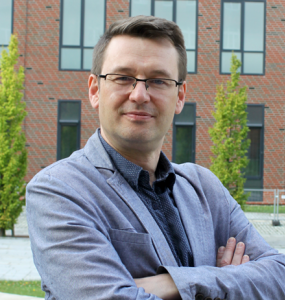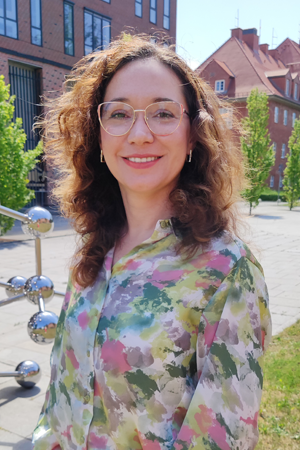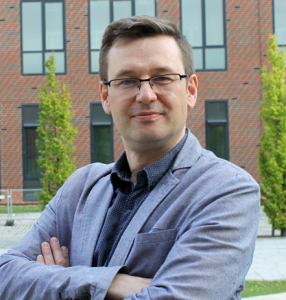Biology of Astrocytes Group
The focus of our team is to understand the function of astrocyte-specific pathways in the brain physiology and pathology, particularly those mediating neurobiological phenotypes related to psychiatric disorders. In current projects, we combine state-of-the art genetic manipulation with live imaging of biological processes in relevant cellular and animal models to identify novel therapeutic strategies.

Michał Ślęzak, Ph.D., principal investigator
Michał graduated from the Université Louis Pasteur in Strasbourg, from the lab of Dr. Frank W. Pfrieger, where he developed a set of novel transgenic mice for astrocyte-specific, inducible gene ablation. Afterwards, he joined Inst. Pharmacology, PAS, in Kraków, where he obtained Young Investigator Award from Polish Ministry of Science and Higher Education. During his stay, he found that astrocytes are an important cellular target in the brain of systemic glucocorticoids. He accomplished his postdoctoral training during Marie Curie IEF fellowship at VIB, KU Leuven. At this time, he obtained the direct evidence for the functional sensory tripartite synapse using in vivo imaging. Simultaneously, he developed a novel methods for flexible genetic manipulation of astrocytes in wild-types animals. His first independent position was at BioMed X in Heidelberg, where he led a project sponsored by Boehringer Ingelheim. Within four years the team has obtained the comprehensive evidence supporting the dysfunction of astrocytes in depression. The project resulted in a new drug discovery program launched by the sponsor.
e-mail address: michal.slezak@port.lukasiewicz.gov.pl

Bartosz Zglinicki, Ph.D.
Bartek graduated from University of Warsaw and then began his PhD studies at the Nencki Institute of Experimental Biology in Warsaw. In both places he was involved in projects focused on metabolism, especially adipose tissue metabolism and it’s regulation by miRNAs. The work has led to discovery of several miRNAs, that were associated with the process of non-shivering thermogenesis. Additionally, Bartek was also involved in side projects within the cognitive neuroscience field, where he grew interest in non-invasive methods of animal behavior assessment and data analysis. Experience in these methods and being influenced by the system of metabolic cages from the previous project, led Bartek to work on automated T-maze system combined with analysis of animals with deep learning. Using deep neural networks allowed for analysis on the level that would be hard to achieve otherwise. Currently, at Łukasiewicz – PORT, Bartek is moving these concepts further and is responsible for implementation of a tool known as a social box, which allows for characterization of more complex animal behavior.
e-mail address: bartosz.zglinicki@port.lukasiewicz.gov.pl

Katarzyna Terejko, Ph.D.
Katarzyna graduated from Jagiellonian University in Cracow and accomplished her Ph.D. degree in the Department of Biophysics and Neuroscience at Wrocław Medical University. In her research, Katarzyna focused on electrophysiological properties of the fast inhibitory synaptic transmission in the adult mammalian brain and she investigated molecular mechanisms underlying the activation process and modulation by benzodiazepines of the GABAA receptor. During her Ph.D. and a short postdoctoral training at Wrocław Medical University, while she continued her research on the relationship between the structure of pentameric ion channels and their kinetics, she discovered an intersubunit interaction and characterized long-range molecular interactions within the GABAA receptor.
e-mail address: katarzyna terejko@port.lukasiewicz.gov.pl

Anna Lech, Ph.D.
Anna graduated from Wroclaw University of Science and Technology and accomplished her Ph.D. at the Department of Molecular Physiology and Neurobiology at the University of Wrocław. During her research, Anna focused on molecular mechanisms of synaptic plasticity in hippocampal GABAergic synapses. As a result, she identified a specific role of matrix metalloproteinases and trans-synaptic interaction between neuroligin-2 and neurexin in inhibitory long-term potentiation. In our team Anna will be responsible for in vivo imaging.
e-mail address: anna.lech@port.lukasiewicz.gov.pl

Viorica Raluca Contu, Ph.D.
Raluca received her B.S. and M.Sc. from Hiroshima University, where she studied toxic dopamine metabolites involved in the etiology of Parkinson’s disease. For her Ph.D. journey, Raluca joined Dr. Tomohiro Kabuta’s group at the National Center of Neurology and Psychiatry in Tokyo as part of a collaborative program with the University of Yamanashi. Her projects focused on the molecular mechanisms and physiological significance of RN/DNautophagy, a non-canonical form of autophagy that targets nucleic acids. Raluca received a Research Fellowship for Young Scientists from Japan Society for the Promotion of Science (JSPS) during her PhD and was also awarded an International JSPS Postdoctoral Fellowship to investigate lysosomal acidification and ATP consumption during cargo delivery in autophagy afterwards. While a postdoc at Rutgers University – Newark, Raluca established iPSC-derived 2D and 3D culture models of Alzheimer’s disease and studied autophagy-associated disease phenotype. In our group, Raluca aims to decipher GR-dependent cell type-specific mechanisms through which chronic stress contributes to the development of psychiatric conditions like major depressive disorder. Do well to do good – yoga and local culture lover.
e-mail address: viorica.contu@port.lukasiewicz.gov.pl

Aleksandra Herud, M.Sc.
Ola graduated in Biomedical Engineering at Wrocław University of Science and Technology. She gained experience working as a bioinformatician at Hirszfeld Institute of Immunology and Experimental Therapy PAS, where she analysed data from Next-Generation Sequencing and third-generation sequencing of bacteria, bacteriophages and SARS-CoV-2. Ola joined Biology of Astrocytes Group to take responsibility of RNA-seq data analysis.
e-mail address: aleksandra.herud@port.lukasiewicz.gov.pl

Tansu Göver, M.Sc.
Tansu obtained her BSc in Molecular Biology and Genetics from Uskudar University, Turkey. During her undergraduate degree, she completed various research periods at University of Oxford, as part of the Erasmus+ Traineeship Programme. Afterwards, she accomplished her MSc in Neuroscience and proceeded to begin her PhD with a keen interest on investigating the role and molecular mechanisms of astrocytes in neuropsychiatric disorders.
e-mail address: tansu.gover@port.lukasiewicz.gov.pl

Patrycja Ziuzia, M.Sc.
Dedicated PhD student focused on advancing behavioral studies, especially in context of depressive- and anxiety-like behavior. My work explores innovative tools to improve implementation of the 3Rs (Replacement, Reduction and Refinement) principles in animal studies.
e-mail address: patrycja.ziuzia@port.lukasiewicz.gov.pl

Paweł Hanus, M.Sc.
Paweł obtained his MSc in degree in Genetics and Experimental Biology at University of Wrocław, where he was identifying astrocytal receptor for transthyretin. Currently in our team he is investigating role of astrocyte’s metabolism in central effects of chronic stress. His main research interest is astrocytal regulation of synaptic plasticity. Privately committed floorball player and hitchhiker.
e-mail address: pawel.hanus@port.lukasiewicz.gov.pl

Martyna Skuła, M.Sc.
Martyna received her master’s degree from the University of Wrocław, and her work focused on the effects of glycogen metabolism disruption on neuronal and astrocytic cultures. In addition to this, she completed a second degree with a specialization in Bioinformatics, during which she worked on the application of unsupervised machine learning algorithms to genomic analysis. Her PhD project was ranked first in the ranking list of the 8th edition of the Implementation Doctorate program. In her work, Martyna is responsible for implementing computational solutions for automating animal behavioral testing.
e-mail address: martyna.skula@port.lukasiewicz.gov.pl

Klaudia Kuzdrowska, M.Sc.
Klaudia holds a Master’s degree in Biology from Adam Mickiewicz University and is currently pursuing a second Master’s degree in Neurobiology. During her studies, she focused on the behavioral patterns of small mammals, participating in research projects conducted across Poland for several years, which sparked her interest in neuroscience. As a Master’s student, she was awarded a grant to investigate the neuroprotective effects of nicotine in Alzheimer’s disease and conducted research related to the genetic disorder Duchenne muscular dystrophy. Later, she spent a semester at Vilnius University, collaborating with a research team exploring the properties of psychoactive substances in neurodevelopmental disorders such as ADHD and autism. These experiences have shaped her academic journey, leading her to her current Master’s thesis, which continues to delve into related topics in neurobiology. Klaudia’s role involves ensuring the care and management of animals, conducting genotyping essential for our studies, and providing support for research projects carried out by the group. Additionally, she is conducting research for her master’s thesis, which is being undertaken jointly with Adam Mickiewicz University and Poznan University of Medical Sciences.
e-mail address: klaudia.kuzdrowska@port.lukasiewicz.gov.pl

Paulina Macierzyńska, M.Sc.
Paulina earned her B.S. in Medicinal Chemistry and my M.S. in Chemistry and Forensic Toxicology at University of Wrocław. After completing her studies, she went on a one-year internship to Dallas, USA, where she worked at the Center for Alzheimer’s and Neurodegenerative Diseases, focusing on chaperone interaction with the model of huntingtin protein. In our team Paulina is responsible for managing the team, maintaining equipment and supplies, and handling orders, budget control, documentation, and laboratory work organization, while ensuring compliance with safety regulations and quality standards.
e-mail address: paulina.macierzynska@port.lukasiewicz.gov.pl
Astrocytes are known for their diverse and essential functions, including neurotransmitters recycling, regulation of synaptic transmission and control over the brain metabolism. These tasks are moderated through systemic signals, including hormones. Our team found that astrocytes are a direct transcriptional target for glucocorticoids in the brain and we identified that crucial metabolic pathways in astrocytes are controlled through glucocorticoid receptor activation. Moreover, we shown that this signaling pathway is necessary for central effects of acute and chronic stress. Interestingly, multiple members of GR-dependent pathway were consistently identified as dysregulated in transcriptomic studies of brain samples from patients of diverse psychiatric diseases. In our current research we investigate the contribution of selected pathways and genes for neurobiological correlates of circuit-specific impairments related to psychiatric phenotypes.
Transgenic mouse models:
- Spatio-temporally controlled genetic manipulations with conditional KO (Cre-ERT2/loxP)
- Viral vector delivery
- In utero electroporation–based method for flexible genetic manipulation in specific cell types across various species
Imaging:
- 1-photon and 2-photon in vivo imaging of astrocyte calcium signaling in behaving mice
- Fiber photometry with simultaneous behavior monitoring in individual mice
- Long-term live cell imaging in vitro
Omics:
- Optimized protocols for isolation of various cell types from mouse brain
- Optimized protocols for isolation of astrocyte nuclei from fresh frozen human samples
- RNAseq, nuclei RNAseq
Behavior:
- Automated live tracking of spontaneous behavior of multiple animals
- Rodent models of stress: chronic social defeat stress, early maternal separation stress
- Depressive-like phenotypes: 3-chamber social interaction, dark-light box, sucrose preference
- Cognitive tests: Y-maze, elevated plus maze
- Circadian activity: running-wheel cages
Cell culture:
- Human iPSC-derived cultures of astrocytes and astrocyte-neuron co-cultures
- Primary mouse astrocyte and neuronal cultures
Metabolic readouts:
- Seahorse (glycolysis rate; oxygen consumption; fuel usage)
- Mitochondrial membrane potential (TMRE)
- Live cell imaging – based measure of glycolytic rate
- Long-term imaging of genetically encoded metabolic indicators in vitro and in vivo
Molecular genetics:
- Standard cloning, Gateway, Gibson assembly, Golden Gate assembly
- Bacterial artificial chromosomes
- Viral vectors
- CRISPR/Cas9 gene editing
- shRNA, siRNA – based gene silencing
Standard readouts:
- Immunocytochemistry
- Immunohistochemistry
- Western blot, Southern blot
- Golgi staining
- ELISA
- RNAscope
Tripartite synapse:
- Slezak M*, Kandler S*, Van Veldhoven P, Bonin V, Holt MG. Distinct mechanisms for visual and motor related astrocyte responses in mouse visual cortex. (2019) Curr Biol. 29 (1-8), 29 (18): 3120 – 3127, DOI https://doi.org/10.1016/j.cub.2019.07.078
- Slezak M*, Grosche A*, Niemiec A*, Tanimoto A, Pannicke T, Münch TA, Crocker B, Isope P, Hartig W, Beck SC, Huber G, Ferracci G, Perraut M, Reber M, Miehe M, Demais V, Lévêque C, Metzger D, Szklarczyk K, Przewłocki R, Seeliger MW, Sage-Ciocca D, Hirrlinger J, Reichenbach A, Reibel S, Pfrieger FW. (2012) Relevance of exocytotic glutamate release from retinal glia. Neuron. 74: 504-16, DOI: 10.1016/j.neuron.2012.03.027
- Kremer A, Lippens S, Bartunkova S, Asselbergh B, Blanpain C, Fendrych M, Goossens A, Holt M, Janssens S, Krols M, Larsimont JC, Mc Guire C, Nowack MK, Saelens X, Schertel A, Schepens B, Slezak M, Timmerman V, Theunis C, Van Brempt R, Visser Y, Guérin CI. (2015) Developing 3D SEM in a broad biological context. Journal of Microscopy 259:80-96, DOI: 10.1111/jmi.12211
- Slezak M, Pfrieger FW & Sołtys Z. (2006) Synaptic plasticity, astrocytes, and morphological homeostasis. Journal of Physiology (Paris). 99:84-91, DOI: 10.1016/j.jphysparis.2005.12.082
- Slezak M. & Pfrieger FW (2003) New roles for astrocytes: regulation of CNS synaptogenesis. Trends in Neuroscience 26: 531-535, DOI: 10.1016/j.tins.2003.08.005
Glucocorticoid receptor signaling and therapeutic approaches:
- Göver T, Slezak M. Targeting glucocorticoid receptor signaling pathway for treatment of stress-related brain disorders. (2024) Pharmacol. Rep 76, 1333–1345, DOI: https://doi.org/10.1007/s43440-024-00654-w
Glucocorticoid signaling in astrocytes:
- Nold V, Portenhauser M, Del Prete D, Blasius A, Harris I, Koros E, Peleh T, Hengerer B, Kolassa I-T, Slezak M, Allers KA. Impact of Fkbp5 × Early Life Adversity × Sex in humanized mice on multidimensional stress responses and circadian rhythmicity. Molecular Psychiatry, DOI: https://doi.org/10.1038/s41380-022-01549-z
- Tertil M*, Skupio U*, Barut J, Dubovyk V, Wawrzczak-Bargiela A, Soltys Z, Golda S, Kudla L, Wiktorowska L, Szklarczyk K, Korostynski M, Przewlocki R, Slezak M. Glucocorticoid receptor signaling in astrocytes is required for aversive memory formation. (2018) Translational Psychiatry 8:255, DOI: 10.1038/s41398-018-0300-x
- Slezak M, Korostyński M, Dzbęk J, Gieryk A, Gołda S , Piechota M, Wlazło E, Przewłocki R. (2013) Astrocytes are a target of the glucocorticoid receptor-dependent component of morphine action. Glia. 61:623-35, DOI: 10.1002/glia.22460
- Piechota M, Korostyński M, Solecki W, Gieryk A, Slezak M, Bilecki W, Ziółkowska B, Kostrzewa E, Cymerman I, Świech L, Jaworski J, Przewłocki R. (2010) The dissection of transcriptional modules regulated by various drugs of abuse in the mouse striatum. Genome Biology 11: R48, DOI: 10.1186/gb-2010-11-5-r48
Genetic tools for astrocytes:
- Edwards-Faret G*, de Vin F*, Slezak M*, Gollenbeck L, Karaman R, Shinmyo Y, Batiuk MY, Menacho Pando C, Urschitz J, Rincon MY, Moisyadi S, Schnütgen F, Kawasaki H, Schmucker D, Holt MG. (2023) A new technical approach for cross-species examination of neuronal wiring and adult neuron-glia functions. Neuroscience. 508: 40-51, DOI: 10.1016/j.neuroscience.2022.11.029
- Shinmyo Y, Saito K, Hamabe-Horiike T, Kameya N, Ando A, Kawasaki K, Anh Dinh Duong T, Sakashita M, Roboon J, Hattori T, Kannon T, Hosomichi K, Slezak M, Holt MG, Tajima A, Hori O, Kawasaki H. (2022) Localized astrogenesis regulates gyrification of the cerebral cortex. Science Advances 8(10):eabi5209, DOI: https://www.science.org/doi/10.1126/sciadv.abi5209
- Slezak M*, De Vin F*, Shinmyo Y, Batiuk MY, Rincon MY, Menacho Pando C, Urschitz J, Moisyadi S, Schnütgen F, Kawasaki H, Holt MG. Flexible, fast and selective genetic manipulation of the vertebrate CNS with misPiggy. bioRxiv, DOI: https://doi.org/10.1101/481580
- Pfrieger FW & Slezak M. (2012) Genetic approaches to study glial cells in the rodent brain. Glia. 60: 681-701, DOI: 10.1002/glia.22283
- Slezak M, Goritz C, Niemiec A, Frisen J, Chambon P, Metzger D, Pfrieger FW. (2007) Transgenic mice for conditional gene manipulation in astroglial cells. Glia. 55: 1565-76, DOI: 10.1002/glia.20570
IPSC-based models:
- Plociennikowska A, Frankish J, Moraes T, Del Prete D, Kahnt F, Acuna C, Slezak M, Binder M, Bartenschlager R. TLR3 activation by Zika virus stimulates inflammatory cytokine production which dampens the antiviral response induced by RIG-I-like receptors. (2021) Journal of Virology 95:e01050-20, DOI: 10.1128/JVI.01050-20
POLS Norway Grants / NCN
NCN OPUS 2022 AstroSyCo
- https://projekty.ncn.gov.pl/index.php?projekt_id=524040
- https://projekty.ncn.gov.pl/opisy/524040-pl.pdf
- https://projekty.ncn.gov.pl/opisy/524040-en.pdf
NCN OPUS 2023 GR traits (in consortium with Dr. M. Korostyński, Maj Institute of Pharmacology Polish Academy of Science, Krakow)
Standardized Approaches to Modeling and Examination of Neuropsychiatric Disorders (SAME-NeuroID) – Twinning, Horizon Europe
WEAVE-UNISONO 2023 Astromics (In collaboration with Dr. Nils Gassen from University of Bonn, Medical Center and Dr. Mathias Schmidt from Max Planck Institute of Psychiatry in Munich)
ERA-NET NEURON 2024 AutoHealth (Dr. Raluca Contu in consortium with Dr. Nils Gassen from University Hospital Bonn, Dr. Mathias Schmidt from Max Planck Institute of Psychiatry, Dr. Mouna Maroun from University of Haifa and Dr. Hale Yapici Eser from Koç University)
Industrial Doctorates:
Patrycja Ziuzia – Wrocław University of Environmental and Life Sciences
Paweł Hanus – Wrocław Medical University
Tansu Gover – Wrocław Medical University
Martyna Skuła – Wrocław University of Science and Technology


